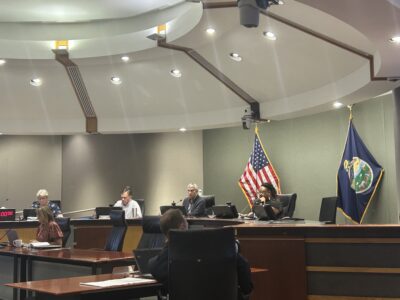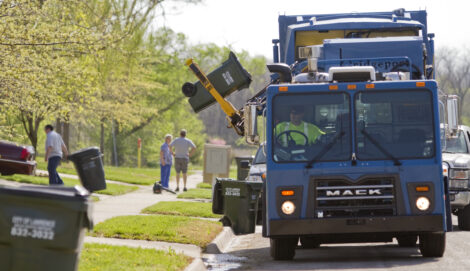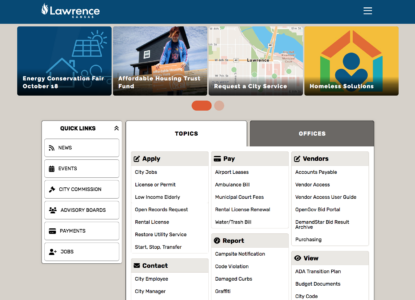A look at the finances of the city’s shelter village for the homeless: 64-square-foot homes at more than $40K each

photo by: Shawn Valverde
Construction at The Village, 256 N. Michigan St., wrapped up Friday, Dec. 1, 2023.
You may not be able to easily picture what 64 square feet equates to, but it is no tough task for longtime Lawrence builder Kelly Drake or others who wear tape measures clipped to their belts.
“That’s a hall bath. That’s a walk-in closet,” said Drake, owner of the building company Mallard Homes.
Soon — the city hopes — it also will be a home. The city’s much-discussed Pallet shelter village on North Michigan Street will feature 50 pre-fabricated living units, each 64 square feet in size, when it opens in the coming weeks.
You know the old saying: Good things come in small packages.
The units indeed are designed to provide a huge societal good, giving people who have been sleeping in tents or on the street a temporary shelter of their own. But as anyone who has ever broken out in a cold sweat in a jewelry shop can tell you, there is a corollary to the saying of good things and small packages.
Expensive things also come in small packages.
Drake and some other local builders are saying the city’s Shelter Village sure appears to be Tiffany-like expensive.
“It is crazy,” Drake said. “Honestly, if you look at these as residential units, they are probably the most expensive residential units Lawrence has ever seen.”
That is a tough statement to verify, but the Journal-World did receive detailed cost data from the city of Lawrence to calculate square-foot costs for the 50 living units and three other 100-square-foot structures the city purchased from Pallet, a company based in Washington state that manufactures the pre-fabricated units.
The city has spent $2.2 million on the project at 256 N. Michigan St. That equates to about $42,000 for each of the 64-square-foot living units, which don’t include kitchens or bathrooms, which builders say are typically the most expensive part of any residential project.
One other way to look at the costs: The city spent about $630 per square foot to construct the approximately 3,500 square feet of living space at the site. Generally, residential construction in Lawrence, whether it be apartments or homes, costs less than $200 per square foot, several builders and commercial real estate agents told the Journal-World.
Drake said those numbers don’t mean the city had bad intentions when it built the units for the homeless, but good intentions don’t always lead to good value. Drake said he can’t figure out how to justify building costs of more than $600 per square foot when he contends any number of builders in the city could have developed a project featuring traditional living units with longer life spans for half that cost.
The Journal-World contacted several architectural professionals who were not involved in the project for opinions on the reasonableness of the city’s costs. While many of the architects expressed sympathy for city leaders and the tough issues they face regarding housing for the homeless, several said the costs seemed high, especially given that the project has not opened in the quick fashion once envisioned by the city. It is one thing to pay a premium for a quick opening, but it’s something else if that quick opening doesn’t come.
Dan Rockhill — a professor of architecture at KU who led students in designing and building a small home project for the homeless in 2021 — said the $2.2 million price tag for the city’s latest project creates “sticker shock.” But he said he’s trying to keep it in perspective.
“It is a lot of money, there is no doubt. Whether they could have gotten more for their buck? Yeah, they probably could have. There are a lot of ways that could have happened, but it was a bit of a panic situation too,” Rockhill said of the city’s decision to pursue the Shelter Village project in March 2023 as community members were expressing grave concerns about both sanctioned and unsanctioned tent camps for the homeless that had sprung up across the city.
Drake said builders generally aren’t unsympathetic to the difficulties facing the city, but he said it is important that the Shelter Village undergo some cost analysis, if for no other reason than to know more about how to better do future projects.
After all, the city and the county are discussing a new strategic plan to combat homelessness that has an estimated price tag of $100 million over the next five years.
“I just want the people of Lawrence and Douglas County to understand what they are actually paying,” said Drake, who said it mattered little to him that the city used federal funds for the project, given that those funds are also taxpayer dollars. “Then it will be up to them to make a decision whether it was a good deal.”
Drake said he’s seen enough to come to his own conclusion.
“Based upon these numbers, I think it was a horrible deal,” Drake said. “As a taxpayer, I think it is a horrible deal.”


photo by: Taylor Mah/City of Lawrence
Workers stand up the walls of a Pallet shelter at The Village, 256 N. Michigan St., on Tuesday, Nov. 28, 2023.
A crisis project
There are lots of adjectives Brandon McGuire, a Lawrence assistant city manager, can use to describe the Shelter Village project. Complex. Challenging. Frustrating. But he also has no problem calling it something much more than that.
“I think we’ve got a great project,” McGuire said. “We have really tried to deliver a project that our community can be proud of and the neighborhood can be proud of.”
When it opens, the project seemingly will deliver a lot of what the city was looking for. It will provide shelter from the elements, yet do so with a design that doesn’t put often traumatized residents in a dormitory-style living arrangement. Although each 64-square-foot unit came with a bunk bed, it is not clear how often units actually will have double occupancy. There also will be support staff in place — employees who are in the process of being hired by the Lawrence Community Shelter, which will operate the project.

photo by: Pallet
The interior of a Pallet structure is shown in this media kit photo from the company.
And McGuire said the city has spent time and money trying to make the project a good neighbor, as traditional residences are near the project’s site. For example, McGuire acknowledges the city increased the project’s cost by burying electric lines at the site, but he said that improved the project’s appearance to nearby homes.
But more than anything, the Shelter Village was a unique project — and not so much because you will have people living in a space that couldn’t contain some West Lawrence shoe collections.
No, it was unique at Lawrence City Hall because it was a project that was largely conceived and executed on the fly. The reason why was simple.
“A year ago, it was full-blown crisis mode,” McGuire said of the period when the city was trying to plan the project.
McGuire said City Manager Craig Owens gave an overarching directive during the process.
“He told us overanalyzing is not an option,” McGuire said. “We are in a crisis. We know it is not going to be perfect and we will learn lessons the hard way.”
McGuire said that guidance led to another overall mindset.
“We really were at that time trying to respond as quickly as we could to provide safe, non-congregate sheltering options with the budget that we had,” he said.

photo by: Pallet
A Pallet structure is shown in this media kit photo from the company.
Changing timelines
Some of that sounds like language the private sector might like. Business, after all, came up with phrases like “back of the napkin” and “fail fast.” But one word doesn’t sit right with the builders.
Quick.
“Can we call this quick?” Drake asked.
The city ordered the structures in March 2023, and it estimates the project won’t be open to residents until March or April of this year. For a point of reference, a traditional single-family home takes six to eight months to build, if a site is ready for construction.
A little research found that several communities that have used Pallet homes for the homeless would not call Lawrence’s timeframe quick. A 2020 article by the L.A. Times found examples of cities that had gone from nothing to completed projects in a matter of weeks or days. (It also found cities that have struggled and spent more than Lawrence has for units.)
Riverside, Calif. erected 30 of the Pallet shelters at a cost of $17,000 per shelter. The project went from start to finish in about three months, according to the article. In Sonoma County, Calif., that community erected 60 of the shelters in 10 days, with a project cost under $22,000 per shelter, according to the article.
In other words, there are examples of communities that have done Pallet projects at about half the per-unit cost Lawrence has experienced, and in a fraction of the time. An attempt to arrange an interview with an official with the Pallet manufacturing company to hear how unusual Lawrence’s timeline has been compared to other Pallet projects was unsuccessful.
What’s clear in Lawrence is that the project has taken longer than city officials expected. When the city ordered the structures in March, the contract called for a delivery no later than July, with a planned opening of the project shortly thereafter.
But the structures themselves had very little to do with the delay. They are designed to snap together with minimal on-site work, and there weren’t reports of problems on that front in Lawrence.
Getting the site ready to accept the shelters, though, did involve significant amounts of time and money. The site previously was home to a private school. The city tore down those buildings at a cost of $68,000, buried utility lines, and did other grading and site work. The city’s site work — including the $725,000 the city paid to buy the property — totaled about $1.4 million, or roughly 66% of the entire project’s cost.
It is numbers like those that astonish private-sector builders. No private-sector project would see the light of day if it proposed to spend $1.4 million on site work to house 3,500 square feet of living space. None would spend more than 60% of its total project costs on land and site work.
“That is not even remotely close,” Tim Stultz, owner of Lawrence-based Highland Construction, said of expected site costs for a project.
It is those costs that have Stultz believing the city missed an opportunity to use once-in-a-generation levels of federal funding — due to the pandemic — to build something longer lasting that could serve homeless communities for decades to come. The city envisions the shelter village lasting five years. Stultz envisioned how the city could have built traditional duplexes on the property. At first they could have been set up to handle the current surge, but then set up to be used in more traditional ways by affordable housing groups.
“You could have built permanent structures there for half the money,” Stultz estimated.
City officials aren’t certain of that contention, but they are acknowledging that there are other options they could have explored. But McGuire said they didn’t, largely because they thought they had found a proven system to get a project in place quickly. Even the builders acknowledge you couldn’t build traditional housing in the four-month timeline the city initially had for the Shelter Village. The city, in part, was paying for the speed.
“If we knew it was going to take a year, we would have pivoted or should have considered other alternatives,” McGuire said.

photo by: City of Lawrence
The city of Lawrence’s site plan for its Shelter Village project is shown.
‘Hard pill to swallow’
If the point of this debate is to learn lessons for the future — rather than to play a game of hindsight is 20-20 — then one of the more important questions may be: Why was the city’s timeline so wrong?
The simple answer is it took the city much, much longer to find an operator for the project than what it expected. McGuire said the city entered the project thinking there was a large market of nonprofits that would be interested in operating a facility in Lawrence.
That ended up being a wrong assumption, and McGuire said the city has learned lessons from it that will be useful in the future.
“I think one thing we learned is the nonprofit sector operates a little bit differently than the private sector,” McGuire said. “Maybe nonprofits are not necessarily looking to expand into new markets.”
Those that were open to expansion, also generally were looking for a larger opportunity. The Lawrence project wasn’t big enough to convince them to open up operations in a new community, McGuire said.
But by the time the city discovered its assumptions about an operator were flawed, it already had spent more than $1.8 million in buying Pallet shelters and the North Michigan property.
“That was kind of a hard pill to swallow,” McGuire said. “It was a gut check when we went out for what we thought was potentially a national market (of operators) and we heard crickets.”
McGuire said the city made the tough decision to shift gears to a “capacity development” strategy, meaning it needed to help an existing nonprofit in the community become capable of running the project. That nonprofit ended up being the Lawrence Community Shelter, which operates the traditional homeless shelter on the city’s eastern edge. It has undergone a reorganization of its board and has hired a new director in recent months.
The systems and staff that are now in place at LCS may be some of the most important developments to come from this project, because they could serve the community for many years to come, McGuire said.
While the end result may be one that the city is pleased with, McGuire can understand why the project has created some concern in the community. There was definite concern in City Hall as questions grew about who would operate the Shelter Village.
“Nobody was coming to bail us out and help us with our problem,” McGuire said of a sentiment that took hold in City Hall. “Here in Lawrence and Douglas County, we have to do that ourselves.”
Lessons learned
The Journal-World reached out to multiple architecture professors at the University of Kansas and Kansas State University about their impressions of Pallet homes, building costs and the challenges of trying to provide housing for the homeless.
A common theme among the architecture professors was admiration that the city of Lawrence is trying.
“At least the city is making an effort to do something,” Rockhill, the KU architecture professor, said.
But there were also concerns expressed. Michael Gibson, an associate professor of architecture at Kansas State, said the industry has seen problems arise with the use of these small, temporary structures that no one believes are appropriate for long-term use. Lawrence, for instance, did not require the Pallet shelters to meet the city’s standard building codes, due to them being temporary in nature.
But what happens if these shelters aren’t so temporary? Gibson said that’s a concern among some architects.
“Many of us in the architecture community had the same concerns about the response to Katrina (the 2005 hurricane), which focused a large amount of federal money to purchase hastily produced tiny homes and various forms of RVs and recreational trailers,” Gibson said via email. “Those solutions ended up harming residents because they did not meet contemporary building standards, and in the absence of good planning and decision-making became longer term than anybody realized.”
Gibson also said he was “surprised” by the costs of the Lawrence project, saying they may be coming at a “fairly high cost versus alternative solutions that could be a more permanent investment and be part of a long term plan for housing.”
Joe Colistra, a professor of architecture at KU, pushes back on some of those cost concerns. The Journal-World’s research found that the structure-only cost for the project was $214 per square foot, meaning that is how much the city spent when site costs and land costs were not included. Colistra said he thinks that price is in line with commercial construction costs, especially given how quickly the Pallet structures can be erected.
The project became more expensive due to land and site costs, but Colistra said it is important to remember that the land is now an asset to the city, and one that Colistra believes the city bought at a good price. Since the Pallet shelters are designed to be temporary, the city will have an opportunity to turn that site into something else, perhaps a different type of affordable housing project. Since the city already has demolished the buildings and buried some utilities, any future project may benefit from cheaper site costs than it would otherwise.
But even more important, he said, is that there is value in using the Pallet structures because they are designed specifically for vulnerable populations, and they provide the entry-level shelter that puts residents on a footing for more permanent housing in the future.
“To think that you are just going to skip that and put people at the most vulnerable point in their lives in a traditional housing project is not a recipe for success,” he said.
Todd Gabbard, an associate architecture professor at Kansas State, said he does think the final costs for the Lawrence project came in high, but also believes people would think differently if the project had been completed more quickly.
The key to a quicker project seemed to have little to do with the buildings themselves and more to do with the fact the city didn’t have an operational plan in place at the beginning of the project. That’s a lesson the city also has acknowledged, and Gabbard urged people to not be too hard on the city.
“There are lots of places around Kansas and Missouri that don’t really take this issue seriously,” Gabbard said of the homelessness and affordable housing problems. “Lawrence has a good history of really trying to tackle the housing issue at all different types of levels.”
He thinks Lawrence will be an interesting community to watch for possible solutions as it continues to devote time and resources to the issue. He said he would encourage the city to do outreach with the local building community and others to get lots of good, locally based ideas.
“We need a lot of solutions that come from a place of ingenuity and earnestness” he said. “It is a solvable problem. I think a lot of people don’t think it is, but it really is. It is imminently solvable.”
At City Hall, McGuire said he also feels good about the position the city will be in for the future. The Shelter Village project has provided good lessons in crisis management, and the new city-county strategic plan on homelessness puts the community in a better position to hear ideas through local outreach. And those are but a few of the lessons learned, and McGuire said they won’t be forgotten.
“I feel good about the project overall, but I also acknowledge that we know a lot more now than we did a year ago when we were first starting to undertake this project,” he said.
For the builders, that is all well and good. Nothing about the Shelter Village project says the city should stop trying to address the issue of homelessness, they said. But if elected officials want community buy-in on potentially $100 million worth of new homeless initiatives, as is contemplated by the strategic plan, cost efficiency is going to be important, they said.
“You have to prove that the money is being spent well and effectively,” Drake said. “That is the first thing the city has to do. Ultimately they are accountable to the citizens and they need to give the citizens the information. We as citizens then need to decide whether we trust the city and the county to spend $100 million on this problem.”
That analysis could lead to more complex questions related to financial versus other types of values. But Stultz said it is important to not gloss over the dollars and cents that went into this Shelter Village project. While there may still be other big questions to answer, he has come to a financial conclusion about that project.
“Any way you cut this thing,” he said, “it is too much money.”
A breakdown of costs
Here’s a look at specific costs for the Pallet shelter village, as provided by the City of Lawrence.
• Pallet Cabin Purchase: $1,113,854*
• Land Purchase: $725,405
• Electric Improvements: $249,757
• Site Improvements: $169,118
• Fencing and Related Costs: $84,672
• Engineering Costs: $82,376
• Demolition Costs: $68,564
• Onsite Storage: $16,967
• Misc. Operating Expenses: $13,576
• Hygiene Trailer: $12,500
• Picnic Table/Bike Racks: $10,285
• Equipment Rental: $7,469
• Misc. Improvement Expenses: $7,262
• Asbestos Testing: $6,783
• ADA Ramp: $4,700
• Cabin Anchors: $3,750
• Trailer Purchase: $3,140
• Mowing: $1,900
• Utility Trench: $1,160
* The city is using about $750,000 worth of the cabins as part of the Shelter Village project. The remainder are in storage, and the city is contemplating using them in a separate project near the Lawrence Community Shelter. In calculating the cost of the Shelter Village project, the Journal-World did not include the costs of the cabins that are in storage.







